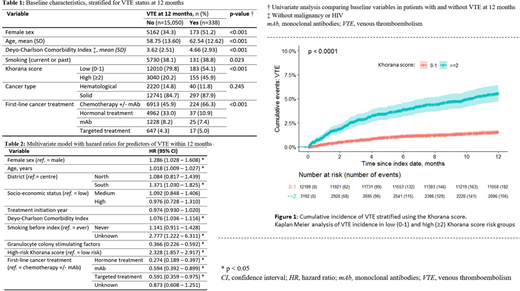Introduction: The risk of venous thromboembolism (VTE) is increased in cancer patients, compared to subjects without cancer. The Khorana score (KS) is used to stratify VTE risk in cancer outpatients and recent society guidelines recommend thromboprophylaxis for patients with KS≥2. The burden of VTE in cancer, current use of thromboprophylaxis and performance of the KS in the Israeli setting are lacking. This data is needed to drive health-care policies regarding risk stratification and thromboprophylaxis.
Aim: Define the clinical need for thromboprophylaxis in an Israeli population of cancer outpatients by determining the cumulative VTE incidence, VTE risk factors and anticoagulation (AC) use.
Methods: This retrospective cohort study was conducted using the comprehensive computerized patient-level databases of Maccabi Healthcare Services (MHS), a nationwide healthcare insurer-provider organization for a quarter of the population in Israel, including 2.4 million members. All newly diagnosed cancer patients aged ≥18 years identified from the MHS cancer registry (excluding non-melanoma skin cancer) who initiated systemic anti-cancer treatment between 2010 and 2018 were included in the study. The cancer registry includes patients with cancer diagnostic codes from the Israel Ministry of Health, linked to cancer medication approvals and pathology reports. Subjects with prior VTE or AC within 3 months prior index were excluded. Patients were indexed on the first day of anti-cancer treatment and baseline variables were extracted, as well as data on AC post-index. The KS was used to stratify VTE risk as low (0-1) or high (≥2) at index. The main outcome was VTE at any site, defined using a validated algorithm based on diagnostic codes and AC prescription data (Sanfilippo et al, Thrombosis Research 135 (2015)). Cumulative incidence of VTE (95% confidence intervals [CI]) at 12 months was calculated and stratified for KS risk group. Univariate and multivariate analysis identified associations between baseline variables and VTE within 12 months.
Results:
The study cohort included 15,388 cancer patients of whom 35% were female with a mean age 58.8 (SD 13.6) years, 85% had a solid tumor, and 46% received chemotherapy as the index anti-cancer therapy. Of these, 338 (2.2%) had a VTE within one year after cancer diagnosis (24% pulmonary embolism with or without deep vein thrombosis [DVT], 76% DVT). Table 1 shows baseline characteristics according to VTE status at 12 months. The 12-month cumulative incidence of VTE (95% CI) was 2.3% (2.1%-2.6%) overall, 1.6% (1.3%-1.8%) in the low-risk KS group and 5.6% (4.7%-6.4%) in the high-risk KS group, as shown in Figure 1.
A multivariate model considered baseline variables shown in Table 1, as well as socioeconomic status, year of diagnosis, district and use of granulocyte colony stimulating factors. In this multivariate model, the following variables were associated with increased risk of VTE in the first year since index date: females, subjects living in the south of Israel, older age, increasing co-morbidity, and high KS. All non-chemotherapy anti-cancer treatments were associated with decreased VTE risk, compared to chemotherapy. Table 2 shows the hazard ratios with 95% CI.
A total of 2896 patients (19%) initiated prophylactic AC after index date (LMWH/unfractionated heparin (UFH) in 2452 (85%)). Among patients with a VTE at any time post-index, 574 (90%) started AC within a median of 2 days (IQR: 0,7) after VTE diagnosis. AC used to treat cancer-associated VTE (defined as AC class 30-days post VTE diagnosis) included LMWH/UFH in 341(74%), direct oral anticoagulant in 74 (16%) and vitamin K antagonists in 43 (9%). Median time on AC after index VTE was 22.1 months (95% CI 17.2-38.4).
Conclusion:
This study confirms that the Khorana score identifies a population of cancer outpatients at higher risk of VTE, and that patients receiving chemotherapy are at highest risk. The association between VTE risk and geographical location in Israel suggests possible health care disparities. The majority of cancer patients with VTE received long term therapy with LMWH.
Funding: This research was sponsored by Pfizer
Conflict of Interest Statement: A. Leader is an employee of Rabin Medical Center who was paid as a consultant to Pfizer in connection with this study. O. Friedman-Mazursky & M. Tirosh are employees of Pfizer Israel. The remaining authors declare no conflict of interest.
Friedman:Pfizer Pharmaceuticals Israel Ltd.: Current Employment. Tirosh:Pfizer Pharmaceuticals Israel Ltd.: Current Employment. Chodick:Novartis Pharma AG: Other: Institutional grant. Leader:Bayer Healthcare: Other: personal fees ; Pfizer Pharmaceuticals Israel Ltd.: Consultancy, Honoraria, Other: personal fees .
Author notes
Asterisk with author names denotes non-ASH members.


This feature is available to Subscribers Only
Sign In or Create an Account Close Modal